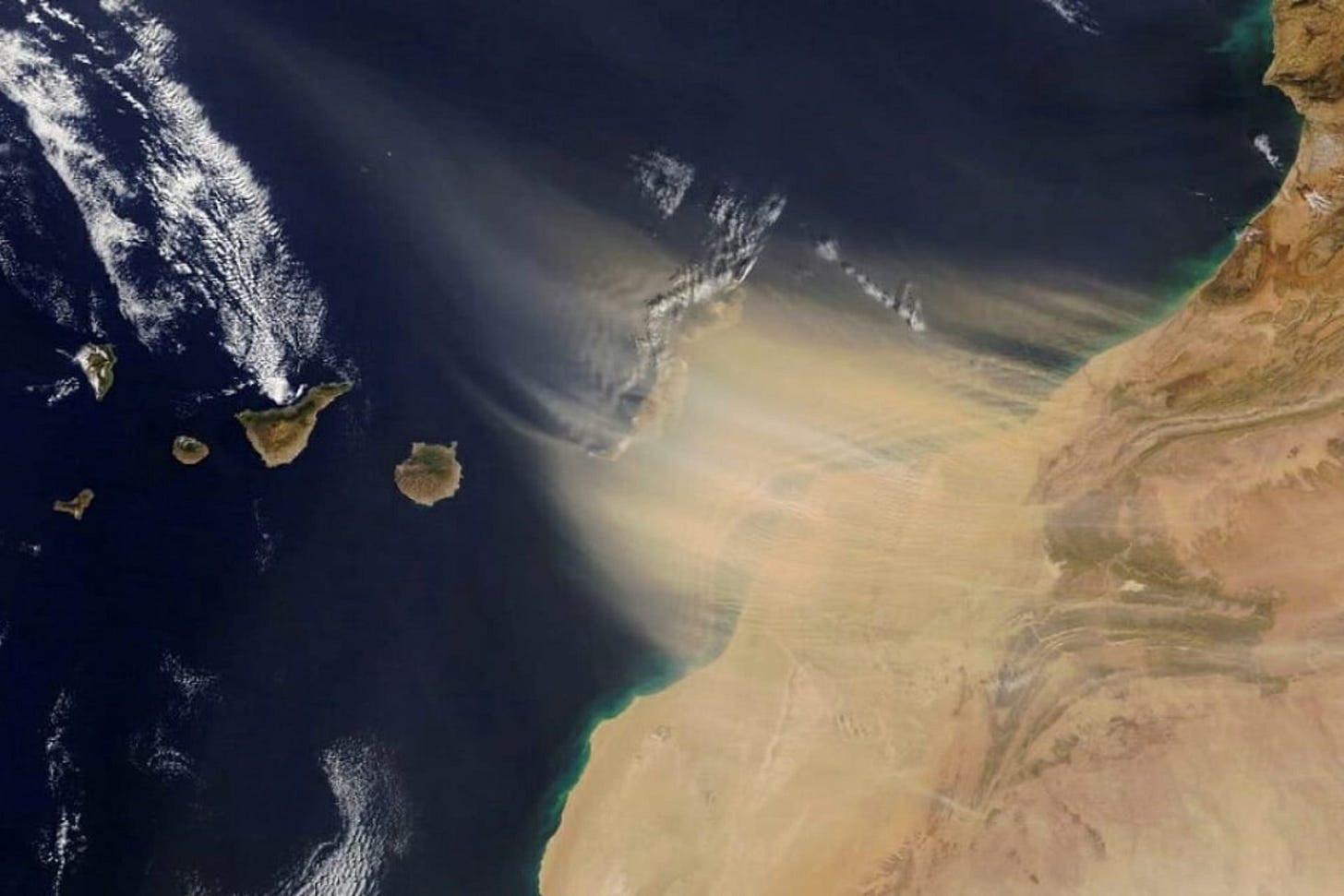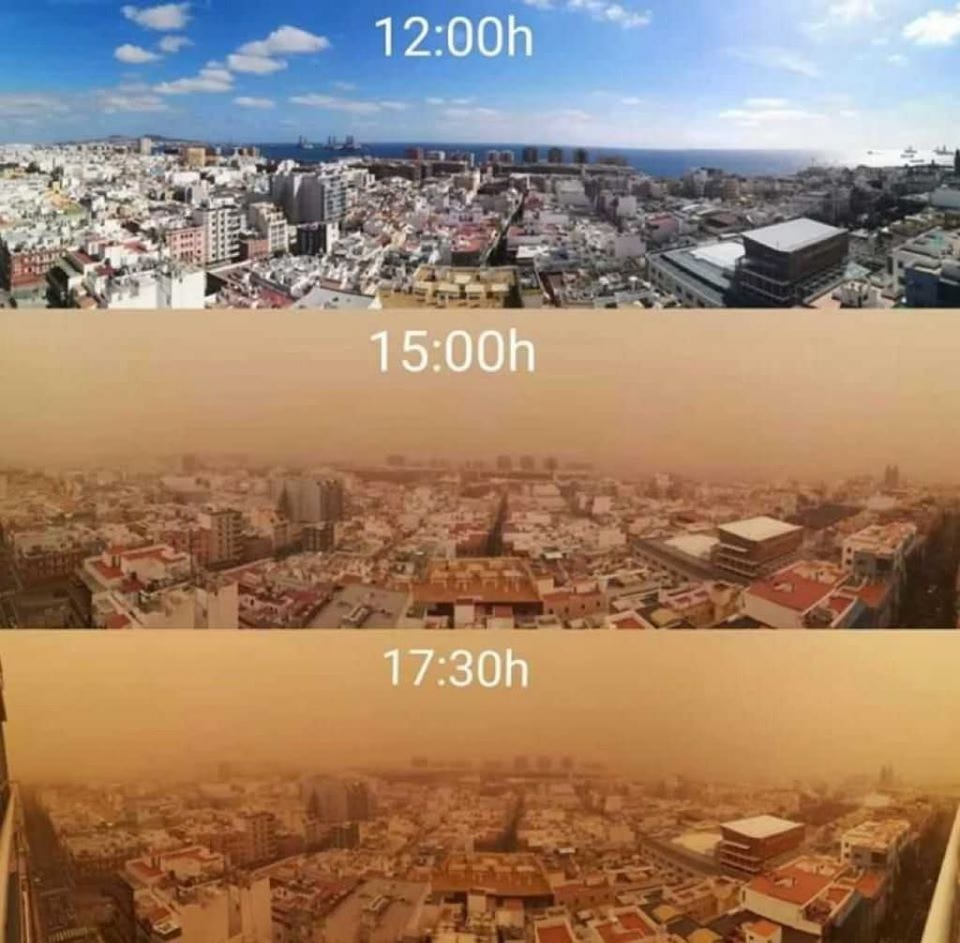We’re visiting the Canary Islands today; our first land and port since leaving The Bahamas seven days ago in this 14-day Atlantic crossing. It’s our first visit here and, in doing some research, I discovered the atmospheric phenomenon they call la calima — a strange, hazy dust-laden air that can be found drifting in from the Sahara. It’s warm, oppressive, strange. Visibility quickly drops. Everything looks muted, dusty. Even familiar places seem foreign under that veil.
Here’s what la calima is, and then what it isn’t — and why it mirrors so powerfully one of the lessons in both The Jacked Up Life and The Jacked Up Church.
What La Calima Is
La calima is wind coming from the Sahara that carries fine sand and dust particles over the Canary Islands. It happens when certain meteorological conditions align: strong southerly or southeasterly winds, dry hot air, and high pressure over North Africa. Source
It reduces air quality and visibility. Streets, patios, cars, everything outdoors gets a thin layer of sand. Indoors, your eyes or throat might prick; outdoors, the sky changes color. Source
It lasts for a few hours to several days — sometimes three to five days, depending on how strong the winds are and how deep the dust layer is. It eventually settles (or is blown away), and life goes back to its usual clarity. Source
What La Calima Isn’t
It’s not a catastrophe by itself. It doesn’t destroy everything, even though it disturbs a lot.
It doesn’t immediately paralyze life (though for sensitive people it can feel overwhelming).
And once the skies clear, people resume their routines.
The Parallel: Hidden Haze in Church Culture
There’s a passage in The Jacked Up Church that goes something like:
“We can repaint walls but leave the foundation cracked. We can preach love but operate in fear. The church sometimes looks clear and bright, until the dust settles in.”
La calima is a good metaphor for that kind of spiritual and cultural haze. You don’t always see it first. You sense it: small irritations, hidden hurts, things that don’t quite feel right but you’ve grown used to them.
Just like la calima, dysfunction in the church can drift in from unexpected places — not always from obvious sin or scandal, but from unresolved conflict, suppressed questions, unmet needs, or an unwillingness to change.
It reduces clarity. The message seems muted. The preaching might still be happening, but it’s generic and forgettable. People don’t see every color in it — nuance, authenticity, honesty are blurred.
The atmosphere becomes thick with dust: unspoken hurt, guilt, performance, only parts of the truth being spoken, masked expectations, resources misaligned.
When the Dust Settles on Your Life
But this isn’t just about churches. La calima also has a lot to say about the way we live our personal lives.
Sometimes the haze doesn’t come from outside voices but from the clutter inside our own heads and hearts.
The dust of distraction. Endless scrolling, overwork, or running from one thing to the next without stopping to breathe.
The dust of disappointment. Old regrets, past wounds, and missed opportunities that hang in the air like a fog, coloring how you see today.
The dust of self-protection. Fear of vulnerability, hiding flaws, keeping the mask on so no one sees the real you.
Like calima, these aren’t always catastrophic storms. They don’t knock us down in one blow. They creep in quietly, coat everything lightly, and make the landscape of our lives feel muted, unclear, and heavy.
And just like the Islanders wait and clean after calima, we have to do the same:
Close some windows of distraction.
Sweep out the settled dust of old hurts.
Wait in grace for clarity instead of forcing answers we don’t yet have.
Because here’s the truth: you can keep moving in the haze, but you won’t see straight. Clarity doesn’t come by pretending the air is clear; it comes by acknowledging the dust, doing the small work of cleaning, and holding steady until the winds shift.
What to Do When You Noticе the Dust
When la calima rolls in, what do Canary Islanders do?
They close windows.
They avoid strenuous exposure outdoors.
They clean surfaces when it settles.
They wait faithfully until the air clears.
Spiritually, we do something similar:
Name the Dust – Call out what is wrong. Maybe it’s not dramatic — maybe it’s a culture of politeness, or people feeling unseen. But acknowledging it is the first step.
Pull the Windows Shut – Establish boundaries. Maybe limit what external expectations you allow, reduce the performance pressures, protect times of rest and prayer.
Clean What’s Settled – Engage in confession, restoration, transparency. Do the work of clearing the dust: apology, honest conversations, care.
Wait for Clarity – Renewal often doesn’t happen immediately. Clarity comes gradually, as air settles, as people see more clearly, as habits shift.
Closing Reflection
La calima reminds us that not everything that blinds is dramatic. Some of the greatest dimming in the church happens slowly — in the haze.
But the gospel is always about bringing clarity, clearing the fog, restoring sight. It whispers that even when the dust is thick, God’s light is still strong. And sometimes, the first faithful thing we must do is simply wait — faithful, expectant, honest — trusting that the air will clear, even if we can’t yet see every star. And then other times, the second faithful thing is knowing when God is moving you out of a place where la calima regularly occurs when others are perfectly content or paralyzed to not make a change. Pray for discernment and always move toward both grace and truth.
If this resonates with you, maybe spend a few moments this week asking:
Where do I feel clouded — what makes the spiritual air thick in my church or in my heart?
What could I do to help clear that atmosphere (confession, truth-telling, asking hard questions)?
Who might need you to stand exposed, clear-eyed — just so the haze begins to lift?
I wrote both The Jacked Up Life and The Jacked Up Church to help people and churches diagnose faulty foundations in their lives and churches and help them pour a new foundation instead of ignoring or patching the cracks beneath. You can find them on Amazon in both paperback and Kindle format!



